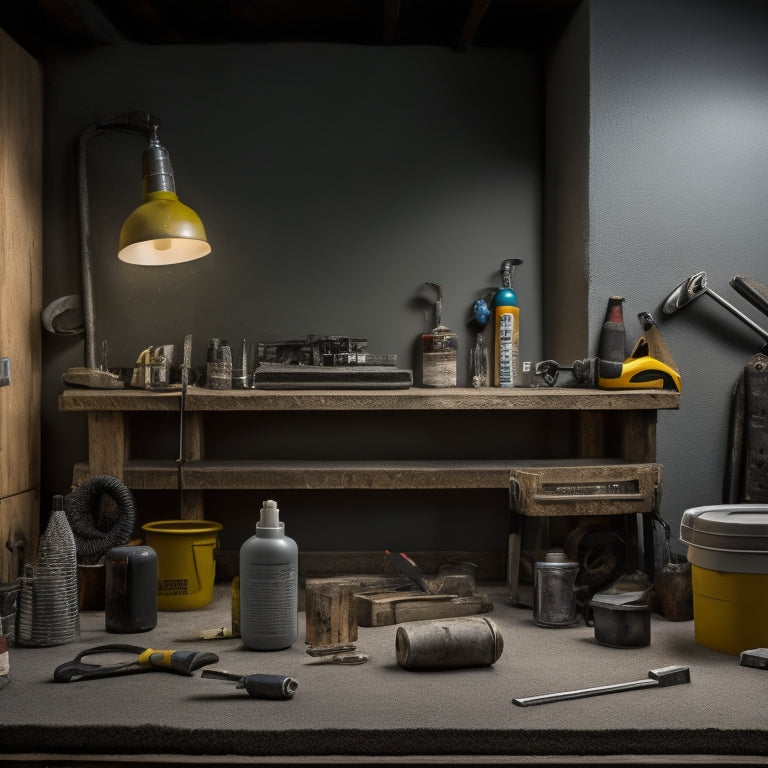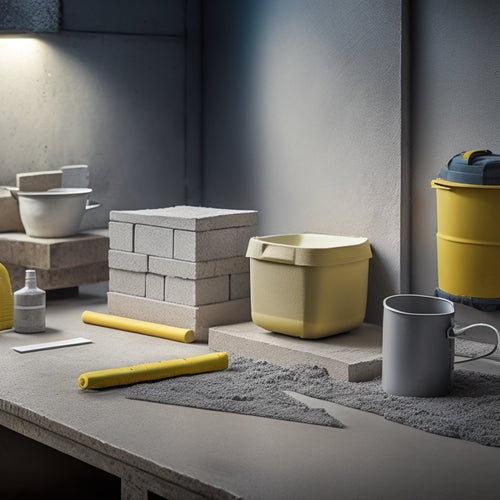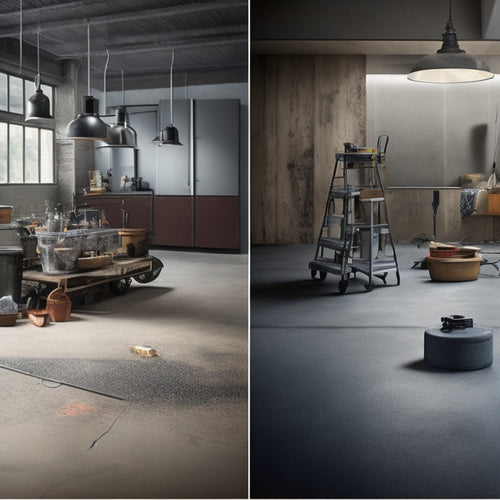
Tools and Materials Needed for Concrete Block Sealing
Share
You'll need a range of specialized tools and materials to guarantee a successful concrete block sealing project, including essential safety gear like gloves, safety goggles, and respirator masks, as well as cleaning solutions with a neutral pH level and balanced surfactant content. Sealant application tools, such as pressure washer equipment, sealant applicator guns, and flow control devices, are also necessary. Additionally, crack repair materials like epoxy, polyurethane, and concrete crack fillers will be required. Moreover, you'll need to evaluate protective coating options like acrylic, epoxy, and silane sealants. As you prepare for your project, you'll want to carefully review the specific requirements for each step.
Key Takeaways
• Essential safety gear, including gloves, safety goggles, and respirator masks, is necessary for protecting against chemical splashes and airborne particles.
• A suitable cleaning solution with a neutral pH level, balanced surfactant content, and water-based or biodegradable solvent is required for effective surface preparation.
• A pressure washer with a minimum 3,000 PSI, wide fan tip, and chemical injector is necessary for thorough cleaning and surface preparation.
• Sealant applicator guns with adjustable pressure output, flow rate, and material compatibility are crucial for smooth and consistent sealant application.
• The right sealant nozzle tips, flow control, and crack repair materials, such as epoxies, polyurethanes, and concrete crack fillers, are vital for achieving a successful seal.
Essential Safety Gear
Wearing essential safety gear, including gloves, safety glasses, and a dust mask, is important when sealing concrete blocks to prevent injuries from chemical splashes, flying debris, and airborne particles.
You'll need safety goggles that provide full eye protection from chemical splashes and flying debris. Make sure they fit comfortably and have an anti-fog coating to maintain clear vision.
Additionally, a respirator mask is essential to filter out airborne particles and prevent respiratory problems. Look for one with a HEPA filter or an equivalent that can capture 99.97% of particles as small as 0.3 microns.
Don't forget to wear gloves that are resistant to chemicals and abrasion. They should fit snugly and provide grip to prevent dropping tools or materials.
A dust mask will also help filter out airborne particles, but it's not a substitute for a respirator mask.
Cleaning Solution Requirements
What type of cleaning solution do you need to effectively remove dirt, grime, and old sealant residue from the concrete blocks before applying a new sealant? The answer lies in selecting the right cleaning solution type that guarantees peak cleaning solution efficacy.
When it comes to cleaning concrete blocks, you'll need a solution that can tackle tough dirt and grime without damaging the surface.
Here are four essential cleaning solution requirements to take into account:
-
pH level: A neutral pH level (around 7) is ideal to avoid etching or damaging the concrete surface.
-
Surfactant content: A solution with a balanced surfactant content helps to effectively emulsify dirt and grime, making it easier to remove.
-
Solvent type: A water-based or biodegradable solvent is recommended to minimize environmental impact and promote safety.
- Concentration level: A concentrated solution can be diluted to the desired strength, providing flexibility and cost-effectiveness.
Sealant Application Tools
When you're ready to apply a sealant to concrete blocks, you'll need the right tools to guarantee a smooth, even coat.
You'll rely on sealant applicator guns to dispense the sealant, and sealant nozzle tips to direct the flow precisely where you want it.
To fine-tune the process, you'll also need sealant flow control devices to regulate the amount of sealant released.
Sealant Applicator Guns
Operating a sealant applicator gun efficiently requires proper technique and a thorough understanding of the tool's capabilities and limitations. You need to choose the right gun for the specific sealant type and application technique. For instance, some guns are designed for high-viscosity sealants, while others are better suited for low-viscosity ones.
When selecting a sealant applicator gun, consider the following key factors:
-
Pressure output: Confirm the gun can generate the required pressure for the sealant type and application technique.
-
Flow rate: Choose a gun that can dispense the sealant at the desired rate to achieve a smooth, consistent bead.
-
Material compatibility: Verify the gun's materials are compatible with the sealant to prevent corrosion or damage.
- Ergonomics and handling: Opt for a gun with a comfortable grip and balanced design to reduce fatigue during extended use.
Sealant Nozzle Tips
You'll need to select the right sealant nozzle tip to achieve a precise, controlled sealant flow and a professional-looking finish. The type of nozzle tip you choose will depend on the specific requirements of your concrete block sealing project.
There are various sealant nozzle types available, each designed for specific applications. For example, a fan-tip nozzle is ideal for sealing large surfaces, while a cone-tip nozzle is better suited for sealing small, intricate areas.
When selecting a nozzle tip, consider the nozzle size and orifice diameter. A larger nozzle size will produce a wider bead of sealant, while a smaller nozzle size will produce a narrower bead. You'll need to choose a nozzle size that matches the width of the joint or gap you're sealing.
Additionally, consider the viscosity of the sealant you're using, as thicker sealants may require a larger nozzle orifice to flow smoothly.
Sealant Flow Control
Selecting the right sealant nozzle tip is only half the battle - now it's time to focus on controlling the flow of sealant as it's applied to guarantee a consistent, high-quality finish.
You'll need to confirm the sealant flows smoothly and consistently to achieve the desired results. This is where sealant flow control comes in.
To achieve ideal flow control, consider the following:
-
Sealant viscosity control: Adjust the viscosity of the sealant to match the specific application requirements. Thicker sealants may require more pressure, while thinner ones may require less.
-
Flow rate adjustments: Regulate the flow rate of the sealant to achieve the desired bead size and consistency. This can be done by adjusting the pressure or the nozzle orifice size.
-
Air pressure regulation: Confirm the air pressure is consistent and controlled to prevent over- or under-application of the sealant.
- Nozzle angle and orientation: Adjust the nozzle angle and orientation to achieve the desired sealant flow pattern and coverage.
Block Surface Preparation
Before applying any sealant, thoroughly clean the concrete block surface to remove dirt, oil, and other contaminants that may interfere with the bonding process. This step is vital, as even the slightest residue can compromise the sealant's adhesion and overall performance.
When evaluating the block surface, look for any cracks, crumbling, or unevenness that may affect the sealant's application. Take note of the surface texture, as rough or porous surfaces may require additional preparation steps. You may need to use a wire brush or sandpaper to roughen the surface, guaranteeing a stronger bond between the sealant and the concrete.
Remember to wear protective gear, including gloves, safety glasses, and a dust mask, when cleaning and preparing the surface. Use a degreaser or a pressure washer to remove stubborn stains or dirt, and let the surface dry completely before applying the sealant.
A well-prepared surface is essential for a successful concrete block sealing project, so don't skip this critical step. By following these guidelines, you'll secure a strong, long-lasting bond between the sealant and the concrete block.
Crack Repair Materials
When it comes to crack repair materials, you'll need to select the right products for the job.
You'll be working with epoxies, polyurethanes, and concrete crack fillers, each with its own strengths and weaknesses.
Epoxies and Polyurethanes
By injecting epoxies and polyurethanes into cracks, you can effectively restore the structural integrity of your concrete blocks. These materials are specifically designed to fill gaps and bind the surrounding concrete, ensuring a strong and durable bond.
When choosing between epoxies and polyurethanes, consider the following key features:
-
Epoxy benefits: Epoxies offer high compressive strength, excellent chemical resistance, and low shrinkage. They're ideal for repairing structural cracks and joints.
-
Polyurethane features: Polyurethanes provide high flexibility, excellent adhesion, and fast curing times. They're suitable for repairing non-structural cracks and joints, as well as filling gaps in moving joints.
Both epoxies and polyurethanes can be used for various applications, including:
-
Low-pressure injection: For smaller cracks and joints, where a lower viscosity material is required.
-
High-pressure injection: For larger cracks and joints, where a higher viscosity material is needed to fill the gap.
Concrete Crack Fillers
You can achieve effective concrete block sealing by utilizing concrete crack fillers, specifically designed to repair and restore the integrity of cracked concrete surfaces. These filler materials are vital for crack prevention techniques, guaranteeing that the concrete remains strong and durable.
When selecting a crack filler, it's important to take into account the type of filler material and its compatibility with the concrete surface. There are various filler material types, including epoxy-based, polyurethane-based, and acrylic-based fillers, each with its own unique characteristics and benefits.
For instance, epoxy-based fillers are ideal for deep cracks, as they provide exceptional strength and bonding properties. Polyurethane-based fillers, on the other hand, are more flexible and suitable for hairline cracks. Acrylic-based fillers are a popular choice for their ease of application and fast-drying properties.
Regardless of the filler material type, it's important to follow the manufacturer's instructions and apply the filler according to the recommended guidelines. By doing so, you can guarantee a successful crack repair and prevent further damage to the concrete surface.
Injection Materials Needed
Effective crack repair requires a thorough understanding of the injection materials needed to fill and seal cracks, as these materials play a critical role in restoring the structural integrity of concrete blocks.
You'll need to select the right materials for your specific repair job, taking into account factors like crack width, depth, and location.
Here are the essential injection materials you'll need:
-
Epoxy-based resins: Ideal for wide cracks (1/4 inch or larger) and high-traffic areas, these resins provide excellent bonding strength and durability.
-
Polyurethane foams: Suitable for smaller cracks (1/8 inch to 1/4 inch) and areas with high moisture, these foams expand to fill gaps and provide flexibility.
-
Acrylic-based sealants: Used for hairline cracks and non-structural repairs, these sealants offer good adhesion and flexibility.
- Cementitious grouts: Appropriate for larger cracks and areas with high structural stress, these grouts provide high compressive strength and durability.
When selecting injection materials, consider the type of crack, environmental conditions, and the desired outcome.
Joint Filling Compounds
Joint filling compounds play an essential role in sealing concrete blocks by filling gaps and voids between blocks, thereby guaranteeing a watertight seal and preventing water infiltration.
You'll need to select the right type of joint compound for your project, as there are various options available. Polyurethane-based, epoxy-based, and acrylic-based compounds are common types, each with its own strengths and weaknesses. For instance, polyurethane-based compounds offer excellent flexibility and are suitable for joints subject to movement, while epoxy-based compounds provide superior strength and durability.
When applying joint filling compounds, you'll need to follow proper techniques to guarantee a successful seal. Clean the joint surface thoroughly to remove dirt, oil, or other contaminants that might affect adhesion.
Then, mix the compound according to the manufacturer's instructions and apply it to the joint using a suitable tool, such as a caulking gun or trowel. Make sure to fill the joint completely, avoiding air pockets or voids.
Power Washing Equipment
When preparing to seal concrete blocks, power washing equipment proves vital for thoroughly cleaning the surface, removing dirt, grime, and old sealers that can compromise the bonding process. You'll need to invest in the right gear to get the job done effectively.
Here are the key components of power washing equipment you'll need:
-
Pressure washer: A gas-powered or electric washer with a minimum of 3,000 PSI to effectively remove dirt and grime.
-
Wide fan tip: A 25-degree or wider fan tip to clean large areas quickly and evenly.
-
Chemical injector: A device that allows you to apply cleaning solutions or degreasers to the surface for more effective cleaning.
- Extension wand: A lightweight, adjustable wand that allows you to reach high areas and reduce fatigue.
When using power washing equipment, it's essential to employ proper power washing techniques. This includes maintaining the correct distance from the surface and adjusting pressure settings according to the surface's condition.
Protective Coating Options
When selecting a protective coating for your concrete blocks, you'll want to contemplate three primary options: acrylic coatings, epoxy sealers, and silane sealants.
You'll need to understand the unique properties and benefits of each to make an informed decision.
In the following sections, you'll explore the characteristics of each type, including their strengths, weaknesses, and ideal applications.
Acrylic Coatings Overview
You can achieve a durable, water-resistant seal on your concrete blocks by applying an acrylic coating, a popular protective coating option that offers a range of benefits.
As a homeowner or contractor, you're likely interested in the advantages of acrylic coatings. Here are some key benefits to examine:
-
UV resistance: Acrylic coatings are formulated to withstand the harsh effects of ultraviolet light, ensuring your concrete blocks remain protected and looking new for years to come.
-
Easy maintenance: Acrylic coatings are easy to clean and maintain, making them an ideal choice for high-traffic areas or environments prone to dirt and grime.
-
Chemical resistance: Acrylic coatings provide a strong barrier against chemicals, acids, and other corrosive substances that can damage your concrete blocks.
- Aesthetics: Acrylic coatings come in a variety of finish types, including matte, satin, and gloss, allowing you to choose the perfect look for your project.
Epoxy Sealer Benefits
Epoxy sealers, a popular and highly effective protective coating option, offer a unique set of benefits that make them an attractive choice for sealing concrete blocks.
When you choose epoxy sealers, you can expect a high level of durability and resistance to wear and tear. One of the significant epoxy advantages is its ability to form a strong bond with the concrete, creating an impermeable barrier that prevents water and other substances from penetrating the surface.
This, in turn, helps to prevent damage from freeze-thaw cycles, acid rain, and other environmental factors. Additionally, epoxy sealers provide excellent chemical resistance, making them ideal for use in areas where exposure to harsh substances is a concern.
The epoxy durability is also exceptional, with some formulations offering a lifespan of up to 10 years or more. Overall, epoxy sealers offer a reliable and long-lasting solution for protecting your concrete blocks from the elements and other forms of damage.
Silane Sealant Properties
Silane sealants boast a unique set of properties that make them an attractive protective coating option for concrete blocks. They offer a breathable, non-film-forming barrier that allows moisture vapor to escape while repelling water and other substances.
As you consider silane sealants for your concrete block sealing project, it's crucial to understand their properties and benefits.
Here are some key silane properties that make them effective:
-
Moisture resistance: Silane sealants penetrate deep into the concrete, providing excellent resistance to moisture and water ingress.
-
Breathability: Silane sealants allow moisture vapor to escape, reducing the risk of damage from trapped moisture.
-
Chemical resistance: Silane sealants are resistant to various chemicals, including acids, alkalis, and salts.
- UV stability: Silane sealants are stable under UV light, ensuring they remain effective even when exposed to direct sunlight.
Measuring and Testing Tools
Accurate measurements and thorough testing are essential in concrete block sealing, and a range of specialized tools facilitates these important steps.
You'll need to employ precise measuring techniques to determine the surface area and substrate conditions of the concrete blocks. This is where tools like digital calipers, micrometers, and precision scales come in handy. These instruments enable you to take accurate readings, ensuring that you apply the ideal amount of sealant.
For testing, you'll require tools that can assess the block's porosity, water absorption, and surface roughness. This is critical in determining the best sealant for the job. Testing methods like the Karsten tube test and the RILEM tube test help you evaluate the block's water absorption and permeability.
Additionally, you may need to use a surface roughness tester to determine the block's texture. By using these measuring and testing tools, you'll be able to gather essential data that informs your sealing strategy, ensuring a successful and long-lasting seal.
Miscellaneous Supplies Needed
You'll need to gather a range of miscellaneous supplies, including cleaning solutions, rags, and applicators, to guarantee a smooth and efficient concrete block sealing process. These supplies may seem minor, but they play a vital role in making certain the success of your project.
Here are some essential miscellaneous supplies you'll need:
-
Mixing buckets: You'll need sturdy, clean buckets to mix your sealant with the recommended amount of water or solvent.
-
Cleaning solutions: A gentle cleaning solution, such as a mixture of soap and water, will help remove dirt and grime from the concrete blocks before sealing.
-
Rags: Lint-free rags are necessary for wiping away excess sealant and cleaning up spills.
- Timer or clock: Keeping track of drying times is essential to make sure the sealant cures properly. Use a timer or clock to monitor the recommended drying time for your specific sealant.
Frequently Asked Questions
Can I Use a Regular Paint Roller to Apply Concrete Sealant?
You're wondering if a regular paint roller will do the trick for applying concrete sealant. While it might seem like a convenient option, it's not the best choice.
The sealant's thick, viscous nature requires specialized roller types, like lambswool or foam rollers, designed for even application. Using a regular paint roller can lead to uneven coverage, pooled sealant, and a subpar finish.
Instead, invest in the right tools to guarantee a professional-looking result with the best protection for your concrete blocks.
How Long Does It Take for Sealant to Fully Dry and Cure?
Imagine you're sealing a 1,000 sq. ft. warehouse floor. You'll want to know how long it takes for the sealant to fully dry and cure.
Typically, curing times range from 24 hours to 72 hours, depending on environmental conditions and sealant type. For example, a silane-based sealant may take 48 hours to fully cure, while an acrylic-based sealant may take only 24 hours.
Once cured, the sealant can last up to 10 years, ensuring your concrete block remains protected and durable.
Do I Need to Seal New Concrete Blocks Immediately?
You're wondering if you need to seal new concrete blocks immediately. The short answer is no, but it's highly advised.
Immediate sealing provides long-term protection against stains, cracks, and damage from environmental factors. If you wait too long, the blocks may absorb contaminants, making sealing more difficult or even ineffective.
Sealing soon after installation guarantees a strong, durable barrier that will last for years to come.
Can I Seal Concrete Blocks During Extreme Weather Conditions?
Don't let Mother Nature rain on your parade!
When it comes to sealing concrete blocks, you're wise to ask if extreme weather conditions are a no-go. The answer is, it depends.
As a general rule, you should avoid sealing during heavy rain, direct sunlight, or freezing temperatures.
For best sealing practices, wait for mild weather with minimal humidity.
Weather considerations are key to a successful seal, so plan accordingly and don't rush the process.
Your patience will pay off with a durable, long-lasting seal.
Will Concrete Sealant Change the Appearance of My Blocks?
When you apply a concrete sealant, you're likely wondering if it'll alter the appearance of your blocks. The answer depends on the sealant type and block texture.
Acrylic and silane-based sealants typically won't change the appearance, as they penetrate the pores without forming a film. However, polyurethane and epoxy-based sealants can leave a glossy finish, which may enhance or alter the block's original texture.
You'll want to choose a sealant that complements your block's natural look, ensuring a seamless integration.
Conclusion
You've made it to the final step of preparing for concrete block sealing.
With the right tools and materials, you'll be able to achieve a professional-looking finish that protects your structure from the elements.
Did you know that 80% of concrete damage occurs due to water infiltration? By sealing your concrete blocks, you'll be preventing costly repairs down the line.
Now, get out there and start sealing!
Related Posts
-

What Tools Do I Need for Concrete Block Laying
You'll need a thorough set of tools to guarantee accurate, efficient, and professional concrete block laying. Essenti...
-

7 Best Tools for Concrete Block Construction
You'll need a solid foundation, precise cutting, and seamless finishing to guarantee your concrete block construction...
-

Top Tools for Revamping Old Concrete Floors
You'll need a range of tools to revamp your old concrete floor, starting with epoxy, acrylic, or polyurethane paint, ...


